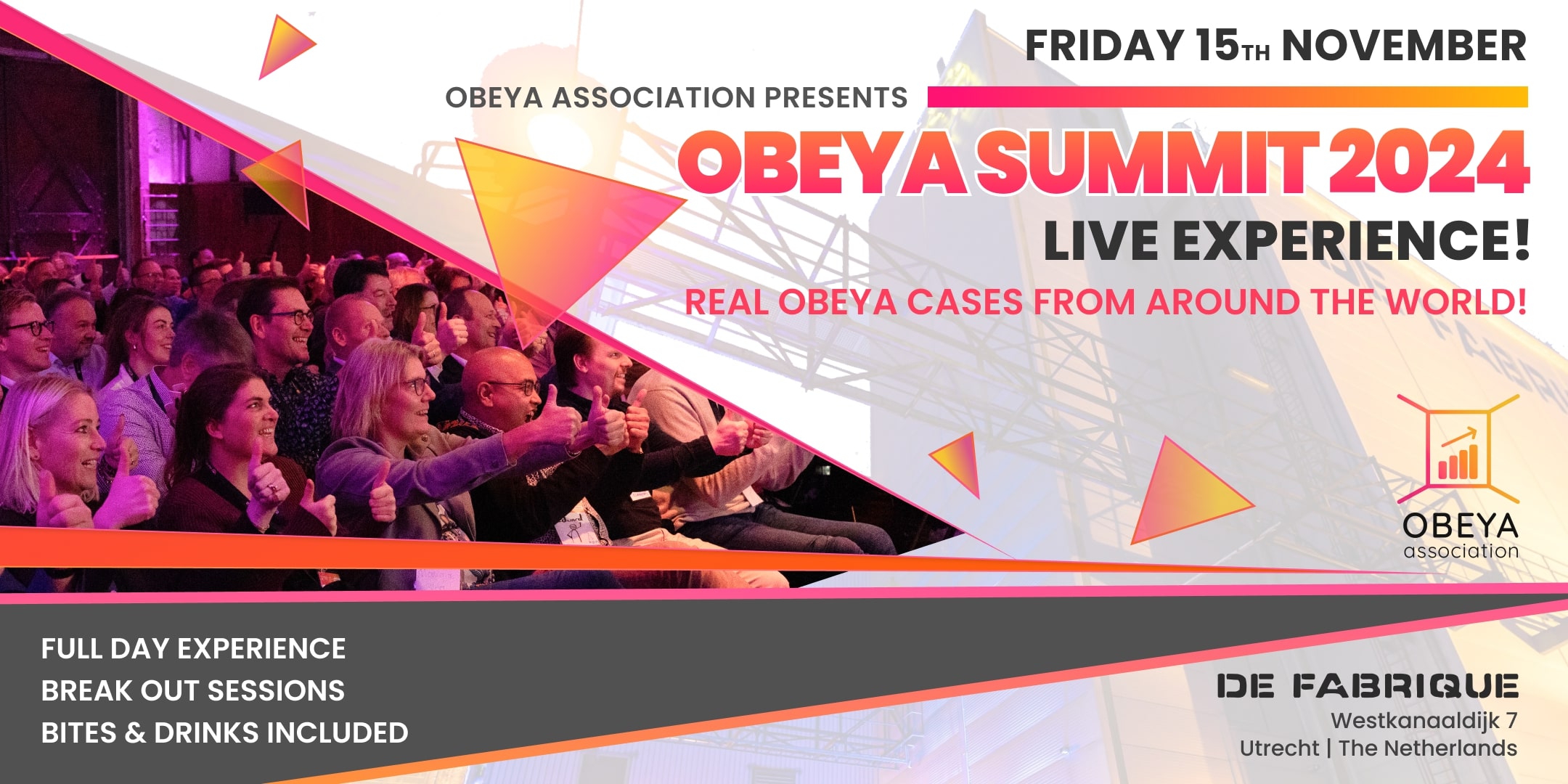
Author of this article: Niels Loader, a leading expert in Lean IT, Agile, and DevOps, is driven by his mission to make excellent IT services accessible to all. He specializes in guiding leadership teams within Lean-Agile-DevOps frameworks and is author of The Lean IT Expert: Leading the Transformation to High Performance IT.
Some Obeyas are doomed from the start.
Let’s assume that through your enthusiasm as a leader and ‘owner’ of the Obeya, the Obeya becomes a success. Then the next hurdle arises: longevity. Will the Obeya still be there in 3 or 5 or even 10 years?
There are signals that your Obeya will not live for a long time. Basic hygiene factors like the willingness of the participants to create the content, the importance given to meetings at the Obeya, the discussion of ‘digital’ over ‘physical’ because “we have the information in a system and what’s the point of writing out something we already have in a system?” and the dominance of one person in the Obeya are all red flags that start flying early on in the process of getting your Obeya to work.
These issues detract from the role of the Obeya. There are many ideas as to what an Obeya is: It’s the ‘mirror’, the control room, the dashboard, the steering mechanism … of your organization. This is all true but it leads us to a focus of ensuring of getting the tool in place, rather than to focus on what we are trying to achieve.
The Obeya is a room in which sufficient information is available to make decisions regarding two key elements: the goals of the organization and the ability of the organizational system to achieve those goals. Of these two elements, the second is by far the most important. Unfortunately, a vast amount of time is expended on determining the goals and, particularly, on understanding the status of the achievement of the goals.
As a leader, your central task regarding the Obeya is to ensure you have designed and implemented an organizational system that can deliver on any of the goals decided upon. And the Obeya helps you to maintain sufficient visibility on that system and what is being processed by the system, to ensure that problems cannot remain unseen. Remember: Deming said it in the 1960’s: “People are already doing their best; the problems are with the system. Only management can change the system.”
The key to success: the system
Before I continue, I would like to define the term ‘system’. A system is a network of interdependent components that work together to try to accomplish the aim of the system. None of the parts on their own can do what the system can do as a whole.
An example: a car is a system. It has a number of interdependent components that work together to ensure that people can go from A to B. Each of the components of a car helps to ensure that journey can happen; some help to make sure that it is done in relative comfort. However, none of the components can fulfil the aim of the system on its own.
Back to our organizational system. An organizational system is a system that aims to achieve the goals of the organization. It has two key components: an operational system and a governance or leadership system.
In the past decade, we have seen substantial activity in the regeneration of the operational system. The aim was to speed up the delivery of value to customers. Many organizations reached for lean or agile methodologies to make this happen. The primary focus was ensuring the ‘delivery teams’ could produce as fast as possible, to keep up with the ever-changing (business/regulatory/societal/…) environment. Altogether, billions of dollars/euros have been (and continue to be) spent on building agility into the operational system of organizations. There have been remarkable successes, but also a substantial record of stagnating successes or transformations that did not live up to expectations.
Rewind: if the aim of the organizational system is to continually improve its ability to deliver value to its customers, then that is what the system should be built to do. As we know, many organizations have put their operational teams through training programs and coaching to achieve ‘agility’. The huge omission is the fact that very little time and energy has been spent on adapting the governance/leadership system to support this aim. And so we see a chasm appear between a new, quite well-defined operational system and an old (traditional) not so well-defined, governance system that is not geared to getting the best out of the new operational system. In short: we have created a mismatch between the operational and leadership systems.
This is the real reason why many organizations are not achieving the productivity benefits that they were expecting.
Leaders have a system too
Enter the Obeya. Obeya has found a large and increasing fan-base in the last 5 years. It has proven its value in many organizations for its ability to give leaders a new sense of control in the world of lean/agile where developments got more and more out-of-hand. The example of an organization of 8400 people with 150 agile teams producing and supporting 1200 apps (for those 8400 people), in which you have lost all sense of what the organization is actually doing is not unique. To a large extent, you have abdicated your responsibility, as a leader, to be ‘in control’ of your organization. Because being ‘in control’ is so 20th century. The problem is: you have a legal requirement to be ‘in control’ of their organizations. The question is: how can you be ‘in control’ without ‘command-and-control’?
“We’ll build an Obeya, because then we will know everything that’s going on in our organization.”
And here we reach the key question: We spent so much time defining and implementing the new operational system, shouldn’t we spend a similar amount of time defining and implementing the new leadership system in the same way?
The Obeya is a symptom of this need. It is one of the parts of a new leadership system, one that helps to visualize the entire system and ensure that you have a view on where the system needs improving.
What do leaders do all day?
The work of leaders can be categorized into activities. These have evolved over the decades from the early 20th Century until today. The initial list of activities was planning, organizing, staffing, directing and controlling. This evolved to forecasting, planning, organizing, coordinating, commanding and controlling. These days we need new words to define what leaders do. Leaders still plan and organize, but we now expect leaders to vision, cascade, monitor and develop. We will look at these activities in more detail later on.
Before we look at the activities, it is important to note that there is a single reason for all these leadership/managerial activities in a modern organization: it is to ensure that operational teams can deliver value in flow to customers and continuously improve that capability. This means that all leadership activities must be focused on ensuring that this reason is embedded in each of the activities. By focusing on this single reason, the organization can truly accelerate its ability to deliver value to its customers.
In the figure below, the practices that are absolutely essential to the success of the leadership system are shown in blue and are the first areas to improve in any shift to a modern way of working. These practices are the keystone practices.

It does not actually matter where we start in the list of activities, because we will need to revisit each of the activities and improve their effectiveness continually, each time ensuring the activity contributes to the acceleration of the organization.
1. Visioning: not just once a year, but every day
Assuming you have an existing situation in which people are organized in some form of structure through which value is delivered to customers, however inefficiently, it is now up to you to create the story for the direction of the organization, and define the essential performance indicators that tell the change story in numbers. The change story is also the basis for the long-term plan.
2. Get actively involved in Planning
You must create a long-term plan for where you wish the organization to go. Through the keystone practices, backlog management and associated capacity planning, you can ensure that the organization works on the right things. Backlog management is about ensuring that the next thing teams do is the task offering the highest contribution to customer value, and is reflected in the units of work (stories, incidents, service requests, etc.) carried out within the teams. Capacity planning is all about ensuring that whatever is asked of the organization from a backlog perspective, must be achievable in terms of the available capacity of people in the operational teams. Balancing the demand for value with the ability to deliver is vital for the long-term well-being of the organization.
3. Cascading: speed up your communication
Cascading is about ensuring that communication flows through the organization. There are three topics that are of particular interest: strategic choices, coordination of work and management of impediments. It is important to note that the communication flows should be rapid and bi-directional, from teams to senior management and the other way around. The strategic choices are directly linked to the planning activities. The cascade is used to communicate and gain input regarding the strategic choices of the organization. In this respect, the cascade is a vital and complementary aspect of planning. It is also used to ensure that work is coordinated across the organization, and that work being carried out by multiple teams is done at the right time to ensure that the result is delivered in flow to the customer. Impediments cause work to stop flowing and need to be tackled promptly. The cascade is used to ensure that the impediment is moved to the level in the organization where it can best be solved.
The cascading activity must be supported by comprehensive visual management (another keystone practice) at all levels. This visual management comes in the form of Obeyas at each of the managerial levels and in the form of team boards at the operational level. Each level has sufficient visual management to ensure that it is clear what work is being done, what work is coming up and whether there are any problems causing delays to the work.
4. Don’t control: Monitor!
Monitoring is one of your most important activities because of its daily nature. In Lean-Agile organizations, monitoring fulfils the ‘Go See’ principle. You collect information for your own decision-making from the boards of the teams for which you are responsible. While on the work floor, you must always encourage continuous improvement (or daily kaizen). As the continuous improvement ‘engine’ of the organization, you must challenge teams to solve problems on a daily basis. Generally, this means focusing on problems that are causing irritation within teams. The problems may be small, but spending a small amount of time everyday tackling these irritants helps to create an environment that is more conducive to high performance.
5. Develop yourself, others and the organization
Following on from the daily removal of impediments, problems and irritants, you must also ensure that larger and deeper problems are solved. This should be done with structured problem-solving. Taking time to solve more complicated or even complex problems increases the capabilities of those solving the problems. It is, therefore, a vital activity for the development of high-performance people and teams: a keystone practice. You must be able to help the teams with problem-solving; not by giving answers but by helping with the structured problem-solving method that will help to reach a high-quality solution. Remember: you must focus on solving the problems in the system; the teams will focus on the operational problems.
6. Organize for flow
Finally, the key focus when organizing is to ensure people are part of a team, preferably one but two is also possible. These teams should be as independent of one another as possible but no more, otherwise the integrity of the organization is no longer guaranteed. Teams must be organized such that they enhance the capability and flow of the value stream. This counts for both operational and leadership teams.
In order to develop a high performance organization that has the ability to accelerate, you must be capable of building and helping to build teams. It is within teams that people can find the safety to experiment and practice, thereby building new skills and knowledge. This links into the need to observe, understand and drive the evolution of behaviors in the team.
Tools help to embed behaviors
A further step in creating your leadership system is to choose the tools you wish to use. In a couple of cases, the tools must be the same to ensure consistency across the organization, e.g. the planning, cascading and problem-solving mechanisms. In other cases, you will have the freedom to develop and use your own tools (e.g. how you do a gemba walk, the tool you use for skills and knowledge analysis). In the end, the tools only help to embed a practice into the organization and as long as the tool does exactly that there are no right or wrong tools.
An organizational system is a clearly defined set of principles, practices and tools that enables you to achieve the purpose of the organization. The Obeya is the place where you should have an overview of that system; the place from which you improve the system.
As stated earlier, it does not really matter where you start when it comes to changing your practices. It is just important to start.
Focusing on team-building will automatically lead to the reconsideration of the constitution of the teams; are they optimally staffed to ensure the flow of work? Or are there still dependencies? This, in turn, leads to a reconsideration or confirmation of the purpose of each team. Does the team still have the same responsibilities or scope? Having checked the purpose of the teams, we must ensure that the work is adequately planned, then cascaded to the right teams. Is it clear who is doing what and when, and do any problems need to be cascaded to a different level of the organization? By monitoring the work and impediments closely, leaders create an environment in which the right challenge is created, and people are asked to solve problems and use these opportunities to improve their capabilities. This brings us back to checking whether the organizational structure still matches the value delivery requirements.
With each cycle, you will be able to improve your ability to facilitate, accelerate and support the delivery of value in a much more effective way than you had previously done with the more traditional practices, all the while standardizing your ability to apply the principles, embed the practices and use the tools. In the end, it is your choice whether you truly wish to be in control or not!
The questions for you are: Do you want your Obeya to remain relevant? Do you want it to continue to be used? If you do, then build the leadership system.





